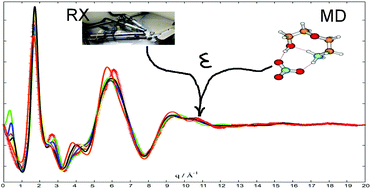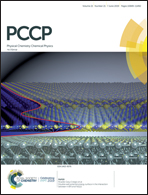Coupled hydroxyl and ether functionalisation in EAN derivatives: the effect of hydrogen bond donor/acceptor groups on the structural heterogeneity studied with X-ray diffractions and fixed charge/polarizable simulations†
Abstract
We present a study by energy-dispersive X-ray diffraction of liquid 2-(2-hydroxyethoxy)ethan-1-ammonium nitrate, NH3CH2CH2(OCH2CH2OH)+NO3− (22HHEAN). This ionic liquid is derived from the parent ethylammonium nitrate (EAN) with an ether link in the chain and a hydroxyl group in the terminal position. The absence of peaks at low-q values in the experimental diffraction curve indicates that the added polar groups and the high conformational isomerism of the cations alter strongly the nanosegregation of the parent EAN liquid. Aggregation between ionic species may involve hydrogen bonding between cations and anions and a variety of intermolecular hydrogen bonds between cations. Diffraction patterns are compared with the results of molecular dynamics simulations with two different force fields: the fixed point charge force field (GAFF) with different charge scaling protocols and the polarizable AMOEBA force field. Most point charge models lead to the appearance of a quite evident low q-peak which decreases gradually, when the percentage and type of the scaling (uniform vs. non-uniform) are increased. In the polarisable model and in the model where only anion charges are scaled to 20%, instead, the pre-peak is absent in agreement with our experiments.



 Please wait while we load your content...
Please wait while we load your content...